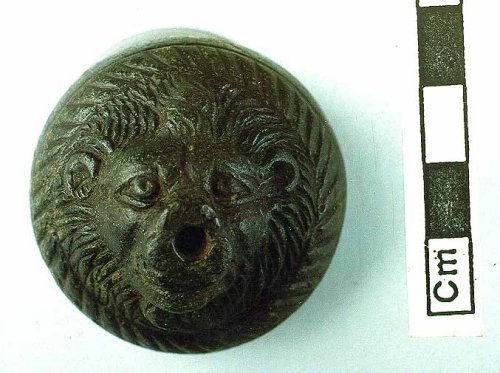|
|
Copper-alloy Lion's Head Furniture Mount from Barton Court Farm, Abingdon: 4th century |

Roman houses were sparsely furnished by our standards. A bedroom for example would have contained only a small table, a chair or stool and a chest for clothes and blankets, apart from the bed or couch which was more like a modern divan. Similar couches were used in the dining room and other day rooms.
The furniture was of light design, usually of wood, and padded furniture did not exist. Instead, decorative embellishments were used in other materials, especially stone and bronze. Bronze mounts were applied to head and foot rests, chairs and stools.
The hollow lion's-head mount was found in a late Roman building at Barton Court Farm, and presumably formed the terminal of a chair arm or similar piece of wooden furniture. The hole centrally in the lion's snout would have held the nail fixing mount to wood; a similar object from Richborough, Kent, still has remains of an iron nail in it. This is one of the few surviving indications of what the furnishings would have been like at this late Roman villa farmhouse outside Abingdon.
Lions had a protective function in ancient art. They are found on tombs (a fragmentary stone lion from a grave monument was found at Shakenoak Roman villa in Oxfordshire) and were used decoratively on domestic vessels as spouts, on keys as handles, and on jewel caskets.
In the ancient Near East sculpted lions guard the thrones of divinities and kings, a function which continued in the art of Medieval Europe.
© 1998 Oxfordshire Museum Service, Setúbal Museums and the Benaki Museum